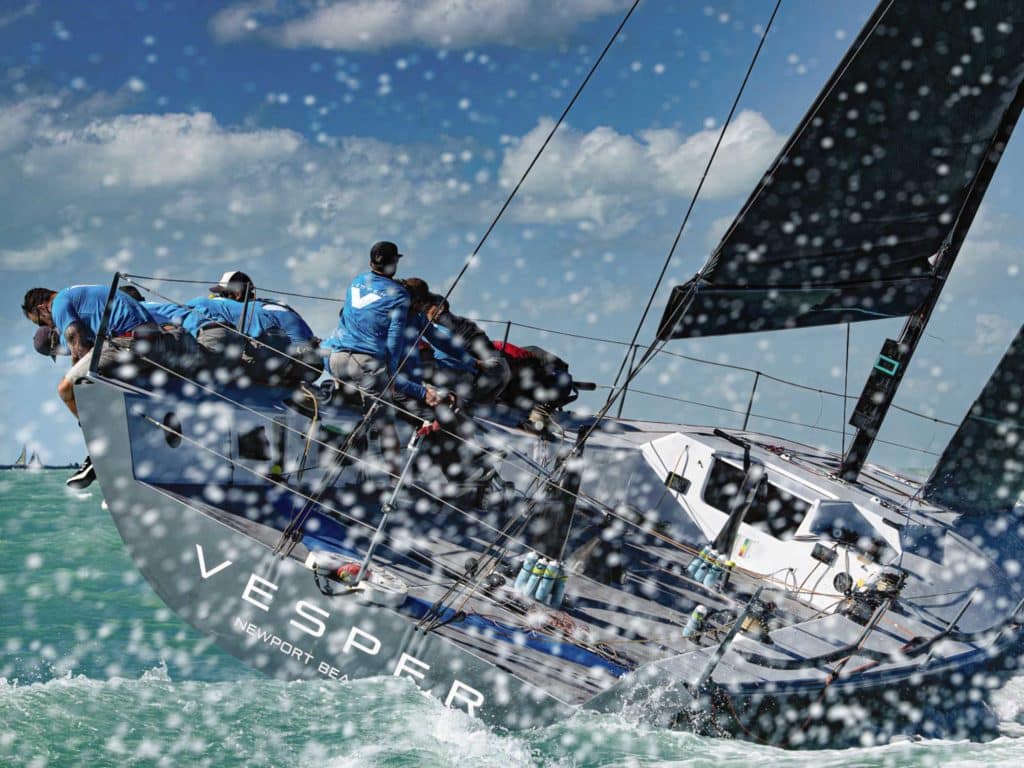
When Marty Kullman finally got home after orchestrating his weeklong Southernmost Regatta in Key West, his phone was lighting up. Texts, emails and phone messages, he says, poured in from people thanking him for pulling off the regatta. “It was off the charts how many people actually took the time to reach out and thank me for bringing us back to the best sailing we’ve done in a long time,” Kullman says. “That and the conditions we had were the highlights for me.”
The Southernmost got its start in 2021 as a getaway regatta for a small band of J/111 class owners. “That was a bit of a test run,” Kullman says. “There was a lot of connecting with city officials, the Navy, the Coast Guard and all sorts of people. Developing relationships with the right people was critical.”
Key to executing the regatta was keeping costs in check, Kullman adds. A big country music festival at the same time presented a pile of challenges with boat launching and housing, but in the end, 48 boats registered, spread across fleets of GL52s, J/111s, Melges 24s and J/70s, as well as a five-boat ORC division. Kullman was adamant the regatta should have a grassroots feel and only two races per day.
Basing operations and the nightly socials at the Galleon Marina, Kullman and his volunteer army delivered with the bare essentials. With the Omicron variant spiking (although you’d never know it on Duval, he says), there was no need to host big parties and secure city permits as in the past. “The socials started right away after sailing at the Galleon with Mount Gay Rum, there was a short awards thing outside at the Tiki Bar with the sunset, and then everyone could go on their way to team dinners or whatever. It worked out great.”
His edict for the racing itself was that it be fun, and he drove that point home numerous times to the many hard-charging professionals in attendance to keep the racing clean and easy. “We had one protest the entire week,” Kullman says. “That was between a couple of the GL52s, and they eventually worked it out between them. So, technically, no protests were heard.”
The list of naysayers is long, Kullman says, but after a week of what owners and crews agree was a classic Key West experience—proven by the explosion of in-your-face, look-at-what-you-missed social media posts—he’s committed to doing it again. And again.
With one running of the Southernmost under his belt, Kullman is unsure how he can continue to grow it, scale it and keep it on the down low, but “what we did is sustainable,” he says. “This is what sailing needs. If it’s the same next year, I’m sure everyone will be happy because it will be as successful, but we know already that there is strong interest from a lot of other classes. We will cap it for sure next year if we need to.”
He’ll do whatever it takes to get people excited about sailing, he says. And he’ll get back to it just as soon as his phone stops dinging. In the meantime, here’s what the winners have to say about their week of fun in the sun.
GL52 Vesper – David Team
It had been about 20 years since David Team set foot in Key West with his sailing gear, but he fondly and easily recalls the glory days of Race Week, racing with his brother in the gigantic Melges 24 fleet of the time. Doing 20 knots in a dinghylike sportboat was a much different experience than the sleepy, light breezes of Newport Beach—an experience he says is seared into his memory.
But that was then and this is now, and this year Team showed up with his GL52, Vesper, which he’s been campaigning since 2018. He’s taken the program on the road over the last few years, competing on the Great Lakes and the East Coast, and when his fellow 52 owners all pushed to put the Southernmost on the calendar, how could he possibly say no?
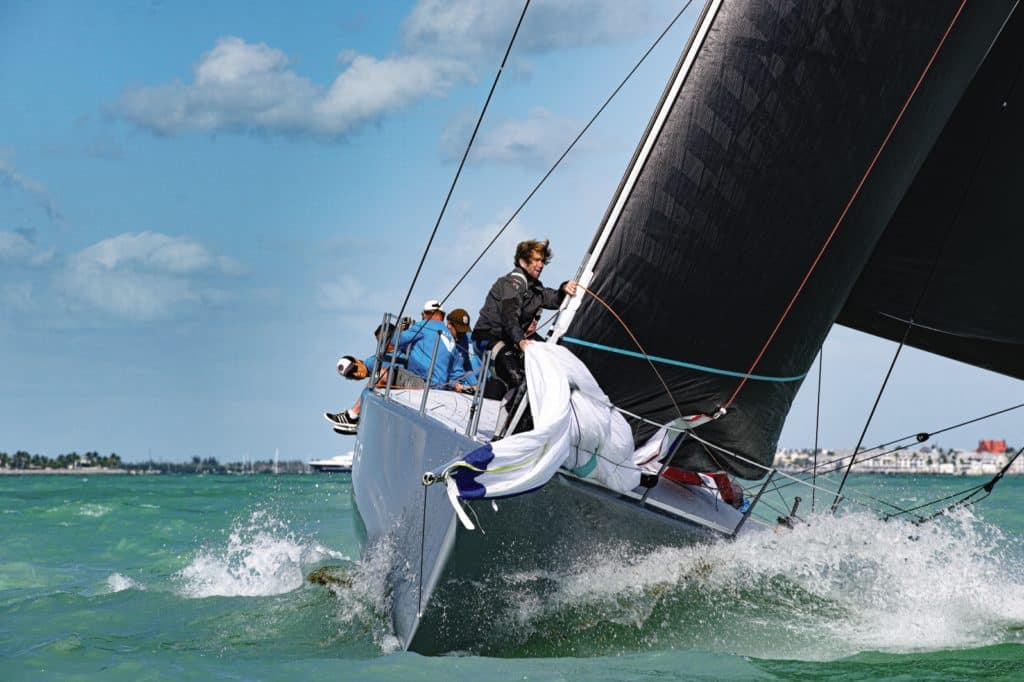
With most of Vesper’s regular crew, led by all-star tactician Morgan Larson, they won five of 12 races in the five-boat fleet—not an easy task given the caliber of those in attendance. Team Vesper excelled in the big breeze of the first four days, even though conditions didn’t necessarily suit their boat.
“With our particular hull form, we actually do OK in the waves with the others, so we don’t mind it,” Team says. “Even though Vesper is a light-air boat, we were fast for the first couple of days, especially downwind.”
Good starts contributed to good finishes, he adds, and a lot of that was Larson’s guidance in the box. “Starting in these boats is a lot of work, and in some cases, it can almost be easier when it’s windy because the boats tend to separate a bit more,” Team says. “You have to stay a bit closer to your boatspeed so you don’t get yourself in trouble. The thing with this fleet is that no one holds back, so you can’t be late either.”
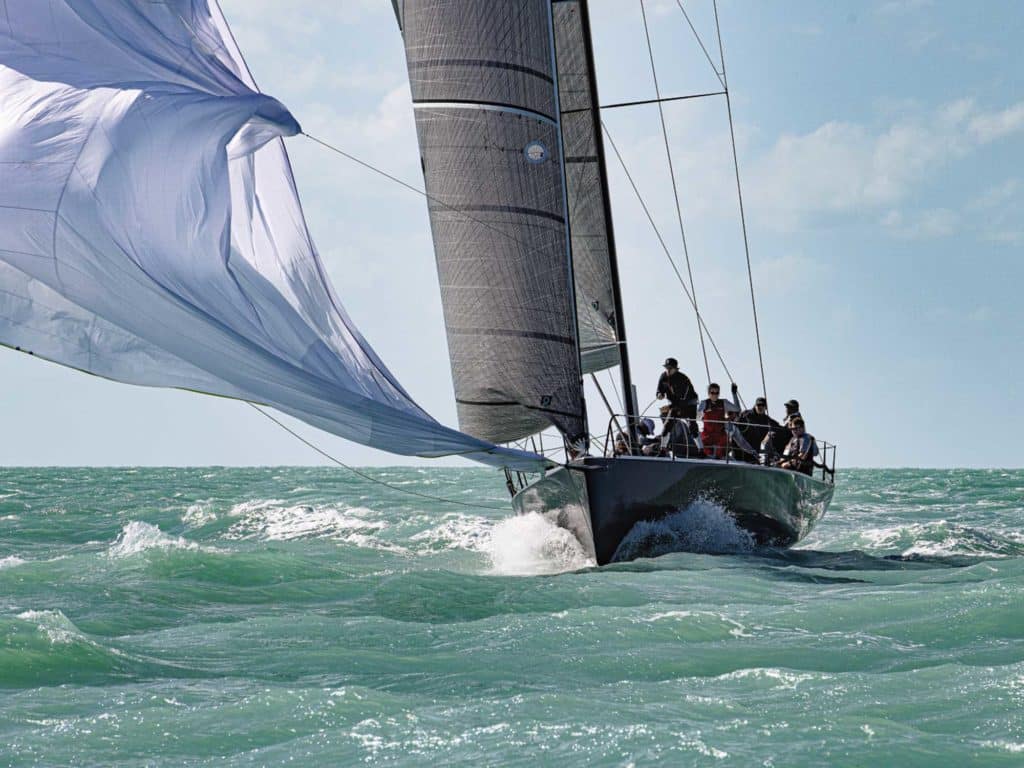
Perfect sailing conditions aside, Team’s personal highlight of the week was a bit of piracy on the final day: “The crew snuck beers on board,” he says. “That was a good way to end it.”
J/70 Dingbat – Bobby Julien
Bobby Julien, of Delray Beach, Florida, declares himself a “total newbie” to sailboat racing, but by the looks of his team’s scores at the Southernmost Regatta, you’d say he’s pulling your leg. But no, it’s true, he says. The last time he skippered a boat with a tiller, he was 13 years old. Julien can thank his three young’uns for his latest obsession. “My kids started racing six years ago, and after watching them and thinking about it for a few years, I finally decided to do it myself,” he says.
But how? And what boat?
He asked around, and all recommendations pointed to the J/70. He eventually found one in Houston, and Dingbat’s first team hire was Alec Anderson, who solidified a squad with Chris Waters upfront and pro trimmer Will Felder on the sheets. One day of practice is all Julien got before being thrown into the J/70 madness in Miami in early January. Then it was straight to Key West for outing No. 2, a much smaller fleet and an opportunity to work on his boathandling. After two days of practice, he was in the thick of it, rifling off wins in six of 10 races. Beginner’s luck, Julien says. But for a guy who had never raced in the big breeze and waves of Key West, he may be underselling his undiscovered talent.
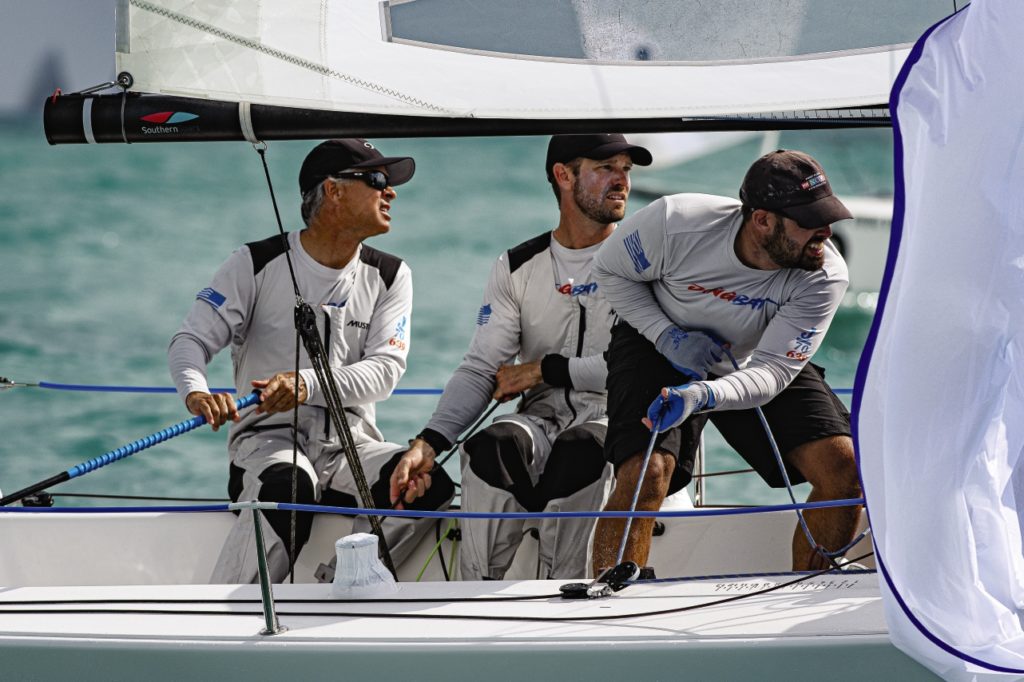
“It was shifty and definitely not easy to steer in the first races,” Julien says. “It takes a lot of concentration, but it was so much fun. I’m so happy I’m back into sailing.”
With less traffic to contend with, they could focus on developing boatspeed and mechanics, and his confidence skyrocketed over five days. “As a new skipper, I was very tense and stressed on the tiller on the first day, and by the end of the week I was relaxing way more,” Julien says, “more confident through the tacks and jibes. It was ugly at the beginning, but that’s what I’m learning—the art of the turn.”
The relaxing vibe of Key West was also an opportunity for the 54-year-old real estate developer to take his mind off work and put it to something else. “Everyone was there to have a good time,” is the first-timer’s takeaway. “It was awesome. In terms of location of a regatta, it was first-class. Great atmosphere—no complaints at all. The venue itself, I now know, is beautiful. The sailing is amazing.”
ORC Interlodge IV – Gwen Fragomen
Austin and Gwen Fragomen’s Interlodge sailing team rolled into Key West with not one, but two slick grand-prix boats: the GL52 for Austin and the Botin 44 for Gwen. The squad of top-shelf pros and their state-of-the-art hardware were no match for the rest of the smaller and much older ORC boats. Interlodge IV won nine of 10 races, losing the one by a mere 3 seconds on corrected time. Some would say it wasn’t fair, but for Olympic 49erFX sailor Stephanie Roble, the results didn’t really matter. It was the experience of a lifetime being part of a big program.
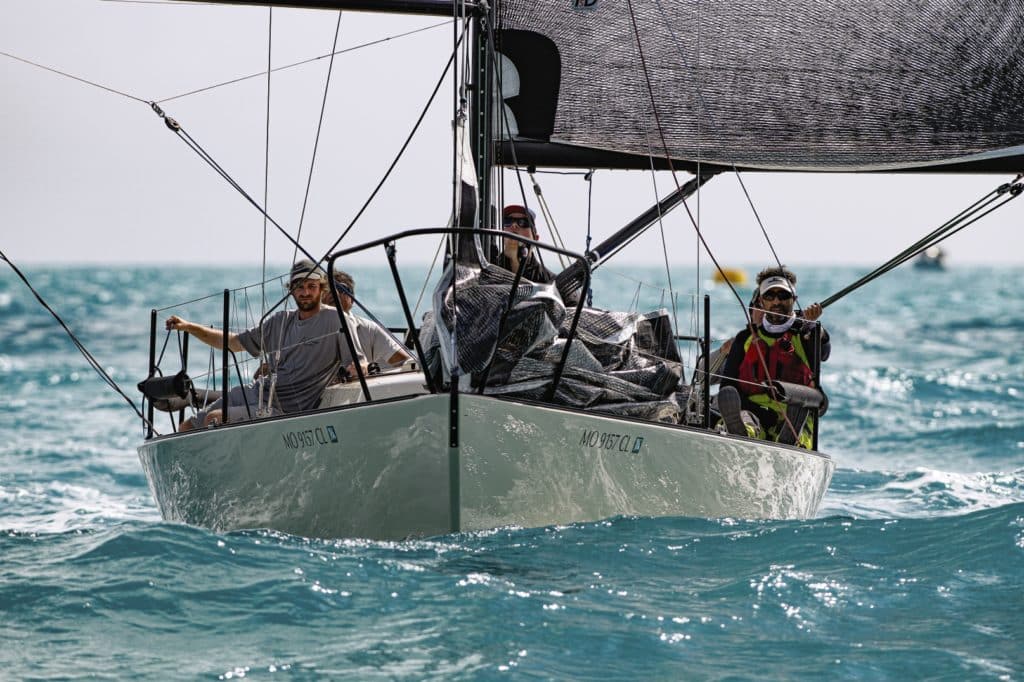
Roble drove the 44-footer for the first day, and for the rest of the week she helmed the starts, passing the wheel to Gwen for the remainder of the race. On the last day, Gwen helmed from start to finish, which Roble says was the team’s goal for the week. “She picked up everything so quickly,” Roble says, “so everyone was really stoked on that.”
But about that first windy day: “It was an amazing experience,” Roble says. “It was an absolute blast, and I really had to pinch myself that I was driving this beautiful boat with this incredible team around me. It was a super-cool moment.”
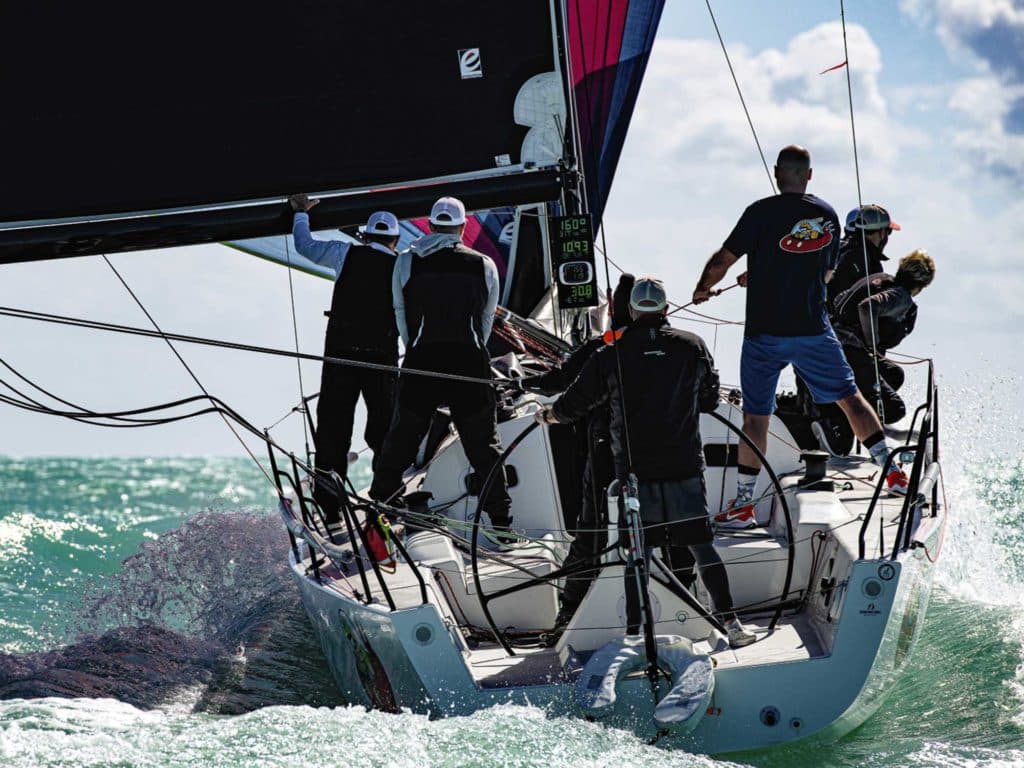
Differences between the tiller of a 49erFX and the carbon wheel of the big speed machine were many, Roble says, especially upwind: “There isn’t much feel to it with such a small rudder. Plus, I’m so used to feeling the wind on my face, and on the trapeze, you can feel everything. Plus, this boat wants to sail upwind at 25 degrees of heel angle—I’m more used to 1 to 2 degrees of windward or leeward heel—so that took some getting used to.”
Eventually, Roble ignored the instruments and sailed the boat as if it were a skiff. “The times when we weren’t going well was when I was looking at the instruments too much,” she says. “When I focused more on the heel—feeling things, looking at the water and listening for the puff calls—is when we started going better.”
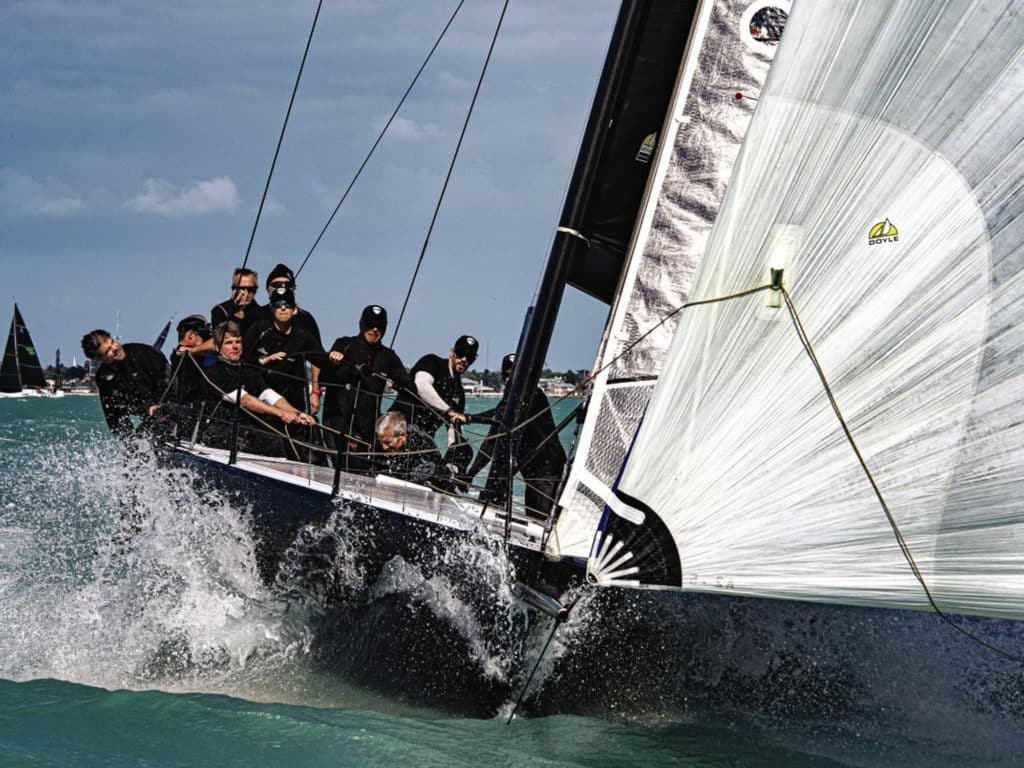
The boat is an apparent-wind machine, just like her 49erFX, so there wasn’t too much adaptation once the big kite was set. “The technique is similar,” Roble says. Turn it up, load up the rudder and send it. But don’t get greedy. “Everything is about trying to find the edge, loading the boat and then releasing it,” she says. “And when you release it, you can really feel the acceleration. It’s sensational. I remember just trying to visualize myself in the 49er, being aggressive on the wheel to keep it trucking the whole time. It was so much fun. I was honored and grateful to be part of the program.”
Melges 24 Raza Mixta – Victor Diaz de Leon
Raza Mixta tactician Victor Diaz de Leon wasn’t doing his teammates any favors on the starting line of the talent-packed 17-boat Melges 24 fleet at the Southernmost. Too much time in the J/70 was messing with his timing. “I was setting us up too early on starboard,” says the J/70 world-champion tactician (with Peter Duncan’s Relative Obscurity). “On the 70, you can sail those slow speeds because of the really fat keel, but the cord length on the 24’s keel is short, so when you set up too early, you slide sideways a lot. And then you’re at the mercy of others coming in from behind with speed.”
With average starts and decent pace upwind, Duncan, Diaz de Leon, Matt Pistay and Greiner Hobbs made their advances on the runs.
“It was so fun and dynamic with the waves downwind,” Diaz de Leon says. “With Erik’s trimming and Peter’s driving—that was a lot of our success because we made our money downwind with really kinetic and aggressive sailing.”
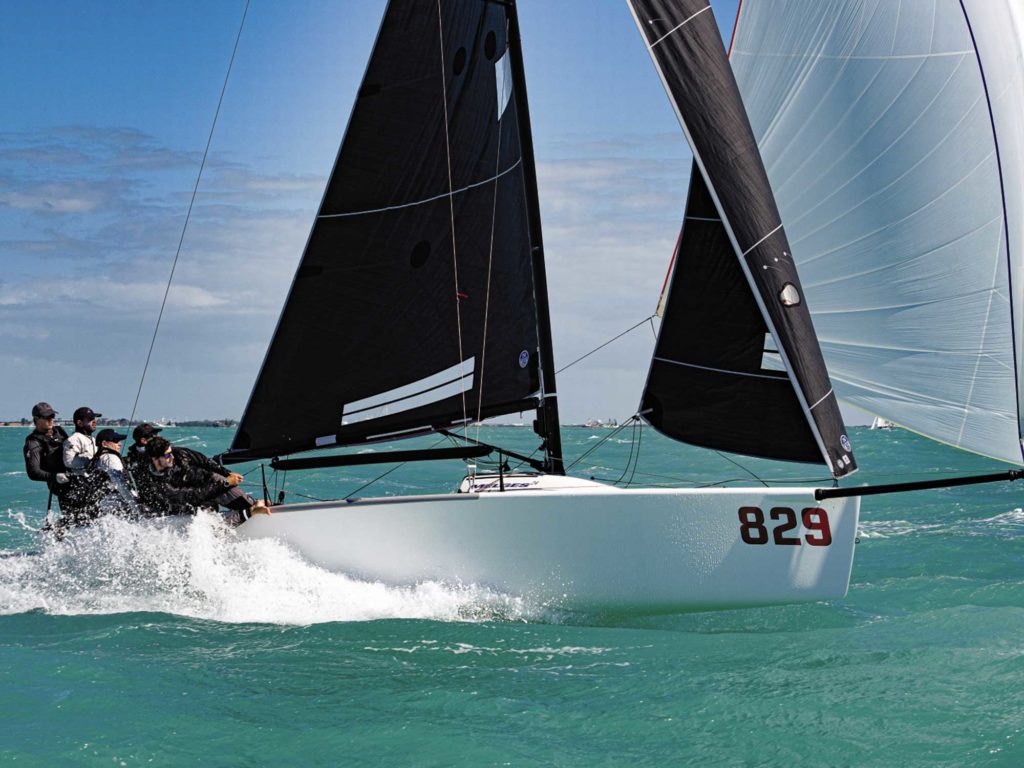
They opened their 10-race series with a third and second, but the next day they put up two wins, banking valuable points that would later come into play. “It was very shifty that day,” Diaz de Leon says. “I was able to pretty much nail the shifts with a bit of luck. I often find myself being too conservative on how much leverage I take. For the last two years I’ve consistently finished second or third, so I started thinking that I have to start trusting my gut a little bit more. That day, I thought there was more breeze on the left, and so I said, ‘Screw it, there’s more wind out left, and I’m not going to tack until we’re into it.’ I finally got it right.”
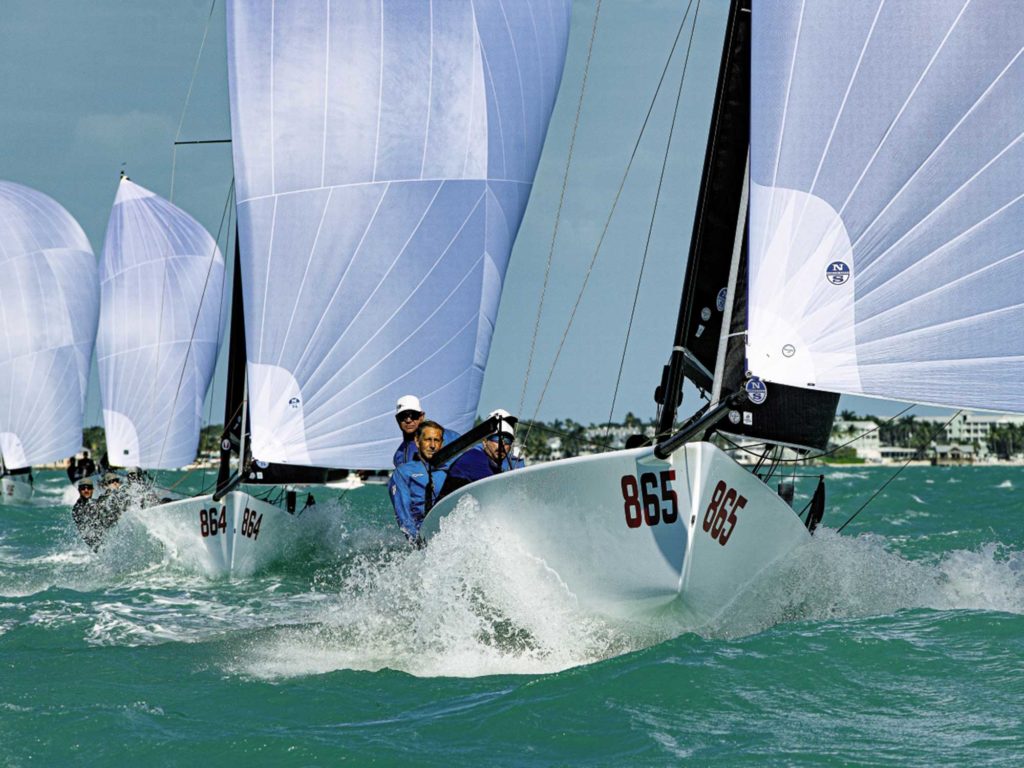
After being runner-up in Key West several times, Diaz de Leon was stoked with the win for his team. “This was one of my favorite regattas ever. The sailing was amazing; the water color, the wind, the conditions were money. When it stopped a few years ago, it was such a bummer, so I was so super-excited to be back.”
J/111 Bravo – Andrew Ward
Every Sunday through the New England winter, Andrew Ward plunges into the Atlantic near his home on Shelter Island, New York. “My buddy from Sweden says it’s good for me,” he says. Invigorating as the cold shock may be, Ward is no fool. He knows the better place to take a dip in January is Key West, and that’s where he and his teammates on the J/111 Bravo found themselves scraping for every inch in the final race to win their division.
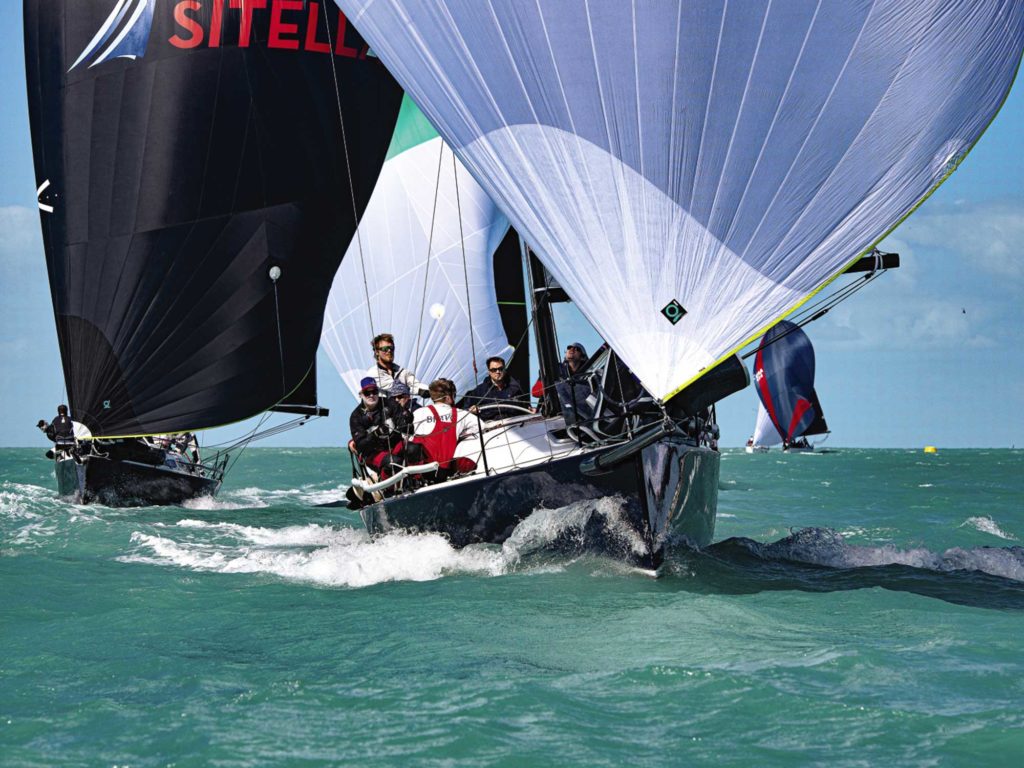
With Bill Hardesty calling tactics, Bravo won the regatta’s first two races, but then fell into a daily pattern of scoring one good race and one stinker. The
second-to-last race of the regatta was their worst—a DFL—which left them facing a complex scenario going into the final one-race day. In order to beat Ian Hill’s Sitella, they had to finish ahead, with one boat between them.
“We went out early—Bill suggested it because our worst races were in light air,” Ward says. “So, we went out and messed around with the rig for a bit, and loosened it to power it up a little better.”
As the helmsman, Ward doesn’t remember much of the final race. He was doing his job keeping his eyes glued to the telltales. Only on the final beat, with the course shortened to an upwind finish, did he take a look around. He could see it was going down to the wire. Approaching the finish, Fireball was close behind them on starboard, but Sitella was on port, so it was hard to judge which boat was ahead. “We beat Sitella, but we had to watch it play out,” Ward says. “We were cheering on the Fireball guys, and only after they finished did my whole body just relax.”
Ward’s 90-year-old father, Sedgwick, who owns and races the boat in Shelter Island, watched it all play out from the sidelines, which made the win all the sweeter. “We’ve been racing this boat for 10 years, with a lot of seconds and thirds, so winning one was really nice, especially in Key West and especially with him watching,” Ward says. “All the firsts we got were awesome, but to go from eighth to winning in the last race—that’s my best Key West moment.”









